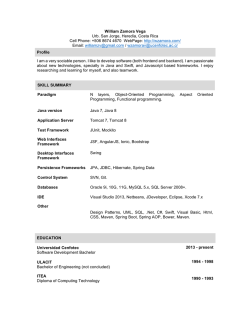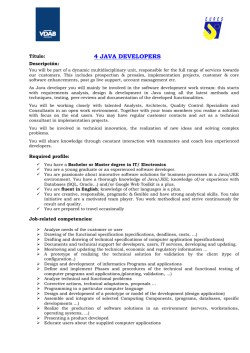
Java Design Patterns
Diplomado – Certificación Duración: 250 horas. Horario: Sabatino de 8:00 a 15:00 horas. Incluye: 1. Curso presencial de 250 horas. 2.- Material oficial de Oracle University (e-kit´s) de los siguientes cursos: - Java Design Patterns - Developing Web Services Using Java Technology - Java Performance Tuning and Optimization - Architect Enterprise Applications with Java EE 3.- 1 voucher de certificación a elegir con 6 meses de vigencia. Requisitos: Es Indispensable traer lap-top con las siguientes características: 1. Procesador: Intel(R) Core(TM) i5 ó i7 Quad Core a 2.0 GHz o un procesador equivalente en Intel o AMD de cuatro núcleos. 2. Tipo de Sistema Operativo Windows 7 u 8 a 64 Bits. 3. Mínimo de memoria RAM: 12 GB. 4. Mínimo de espacio en Disco 150 GB disponibles. Java Design Patterns Reviewing Object-Oriented Principles in Java Describe how OO concepts apply to Java Describe how OO principles apply to Java List the goals of an OO language Interpret Unified Modeling Language (UML) notation and create UML diagrams Identify selected design patterns Reviewing Gang of Four Patterns List key behavioral, creational and structural patterns Apply the Facade pattern Apply the Strategy pattern Apply the Observer pattern Apply the Composite pattern Review the Model-View-Controller (MVC) patterns Implementing Patterns in Java Use implementation patterns designed for Java List forces affecting class, state, and behavioral patterns Describe how patterns, idioms and refactoring differ from each other Exploring Changes in Java EE Technology Describe the design goals of the Java EE model Describe improvements in the Java EE 6 model Implementing Integration Patterns Describe design patterns for the integration tier Review Java EE integration changes that apply design patterns Identify use cases for applying integration tier patterns Implementing Patterns in Business Components Describe the role of an enterprise bean Describe design patterns for the business tier Implementing Infrastructural Patterns in Java EE Describe the role of infrastructural Java EE patterns Describe the Service Starter pattern Describe the Singleton pattern Describe the Bean Locator pattern Describe the Resource Binder pattern Implementing More Infrastructure Patterns Describe how Java EE interceptors work Describe the Dependency Injection Extender pattern Describe the Payload Extractor pattern Describe the Context Holder pattern Describe the Thread Tracker pattern Exploring Anti-Patterns Describe the Law of Leaky Abstractions Define AntiPatterns Describe Integration Tier AntiPatterns Describe Business Tier AntiPatterns Describe Presentation Tier AntiPatterns Selecting Patterns for Architecture Define the roles of architect, designer, and developer Describe the relationship between design patterns and architecture List guidelines for applying patterns to an architectural solution Java Frameworks (Spring, Hibernate, PrimeFaces, JQuery, Struts 2, Maven) Maven ¿Qué es Maven? Características Clave POM – Project Object Model Project Unique Identifier – GAV Repositorios Gestión de Dependencias Dependency Scope Ciclo de vida de Construcción (Build lifecycle) Arquitectura de Plugins Práctica - Construcción de un proyecto con maven Práctica - Integración con Eclipse Spring ¿Qué es Spring? Spring Core Inversión de Control (IoC) Inyección de dependencias (DI) Spring Bean Factory y Application Context Ciclo de Vida Definición de Beans. Configuración por XML Configuración por Anotaciones. Práctica - Singleton y Prototype Práctica - Definición de componentes orientado a Interfaces Práctica - Convertidor de número a letra multi-idioma Hibernate 4 ¿Qué es un ORM? ¿Qué es Hibernate? Arquitectura Dependencias Maven Mapeo de Entidades Configuración de Hibernate Sesiones y Transacciones Uso de Hibernate (CRUD) Relación uno a uno Relación uno a muchos Claves primarias y tipos de dato Componentes y enumerados Consultas personalizadas con Query y HQL Struts 2 Creación de proyecto web Ciclo de Vida Configuración Struts 2 Actions Formularios con Struts Value Stack Interceptores Configuración con Anotaciones jQuery JSON Ajax DOM Selectores RIA – jQuery y jTable (Demostración) Integración proyecto empresarial multi-modulo Requerimiento funcional del sistema propuesto Definición de arquitectura Desarrollo de módulos del proyecto con maven Definición Capa Dominio Definición Capa Persistencia Definición Capa Persistencia – Hibernate Definición Capa Persistencia – Spring JDBC (ejemplo extra) Definición Capa Servicio Definición Capa Utilerias Definición Capa Web Implementación de aplicación web orientada a servicios Developing Web Services Using Java Technology Introduction to Web Services Explore the need for web services Define a web service and describe the motivation behind developing and using web services in business software Describe the characteristics of a web service Describe the two major approaches to developing web services Describe the advantages of developing web services within a JavaEE container. JAX-WS-based Web Services Understand how to create web services using JAX-WS Understand how to deploy web services providers using JavaSE Understand how to create and deploy simple web services clients using JavaSE. SOAP and WSDL Understand the basic structure of a SOAP message, and how it is encapsulated by transports Understand how WSDL defines a web service, including its message representation and transport mechanism Understand the different styles of SOAP messages that a web service can use, and their trade-offs Customize a web service to control the style of SOAP message that that web service will use JAX-WS and JavaEE Understand how to deploy POJO web services to a web container Understand how to define a web service in terms of an Enterprise Java Bean Understand how to deploy an EJB web service to an EJB container Describe the benefits associated with implementing a web service as an EJB Implementing More Complex Web Services Using JAX-WS Apply JAXB to pass complex objects to and from a web service Understand how to map Java exceptions from a web service endpoint to SOAP faults Understand how to inject attributes into JAX-WS web service endpoints Describe JAX-WS artifacts that can be injected and how to use them AX-WS Web Service Clients Understand how to create web service clients using JAX-WS Understand how to create web service clients using JAX-WS that support asynchronous interactions Introduction to RESTful Web Services Understand what RESTful Web Services are Understand the five principles behind RESTful Web Services Understand the advantages and disadvantages of a RESTful approach. JAX-RS-based Web Services Understand how the five principles of RESTful web services map to JAX-RS constructs Understand how to implement REST web services using JAX-RS Understand how to deploy REST web services using Jersey, an implementation of JAX-RS JAX-RS-based Web Service Clients Understand how to create JAX-RS clients using URL and HttpURLConnection. Understand how to create JAX-RS clients using the Jersey Client API. JAX-RS and JavaEE Understand how to deploy POJO web services to a web container Understand how to define a web service in terms of an Enterprise Java Bean Understand how to deploy an EJB web service to an EJB container Describe the benefits associated with implementing a web service as an EJB Implementing More Complex Web Services Using JAX-RS and Jersey Understand how to produce and consume custom types. Define JAX-RS web services that provide results by linking to other resources. Understand how to manage exceptions. • Define JAX-RS web services in terms of resources and sub-resources. Understand the different scopes defined by JAX-RS for web services endpoints. Trade-Offs Associated with the Java Web Services APIs Understand the trade-offs involved in the choice to implement a web service using either JAX-WS or JAX-RS technology. Web Services Design Patterns Describe web services-based design patterns Describe web services-based deployment patterns Best Practices and Design Patterns for Use with JAX-WS Describe JAX-WS-specific design patterns Recognize and apply best practices associated with implementing web services using JAXWS Best Practices and Design Patterns for Use with JAX-RS Describe JAX-RS-specific design patterns Recognize and apply best practices associated with implementing web services using JAXRS Java Performance Tuning and Optimization Introduction to Java Performance Tuning Course Introduction Course Agenda JVM and Peformance Overview JVM Overview Performance Principles Common Performance Problems Performance Methodology Development and Performance Monitoring Operating System Performance Monitor CPU Usage Monitor Network I/O Monitor Disk I/O Monitor Virtual Memory Usage Monitor and Identify Lock Contention Monitoring the JVM HotSpot Generational Garbage Collector Monitor the Garbage Collector with Command Line Tools Monitor the Garbage Collector with VisualVM Monitor the JIT Compiler Throughput and Responsiveness Performance Profiling NetBeans Profiler, Oracle Solaris Studio, and jmap/jhat Profile CPU Usage Profile JVM Heap Find Memory Leaks Identify Lock Contention Heap Profiling Anti-patters Method Profiling Anti-patterns Garbage Collection Schemes Garbage Collection Generational Garbage Collection GC Performance Metrics Garbage Collection Algorithms Types of Garbage Collectors JVM Ergonomics Garbage Collection Tuning Tune the Garbage Collection Select the Garbage Collector Interpret GC Output Language Level Concerns and Garbage Collection The best practices for Object Allocation Invoking the Garbage Collector Reference Types in Java The use of Finalizers Performance Tuning at the Language Level String-efficient Java Applications Collection Classes Using Threads Using I/O Efficiently Architect Enterprise Applications with Java EE Introducing Enterprise Architecture What is Enterprise Architecture? An Architect’s Roles and Responsibilities Introducing Fundamental Architectural Concepts Distinguish between architecture and design Architectural Patterns Architectural Deliverable Artifacts What is an Enterprise Architecture Framework 4 + 1 View Model Architectural Modeling Using UML Architecture Workflow What is an Enterprise Architecture Framework Developing a Security Architecture Analyzing the Impact of Security in Distributed Computing Examining Security in the Java EE Technology Understanding Web Services Security Understanding Non-Functional Requirements Examining Non-Functional Requirements (NFRs) Common Practices for Improving Qualities Prioritizing Quality-of-Service (QoS) Requirements Inspecting QoS Requirements for Trade-offs Defining Common Problems and Solutions: Risk Factors and System Flexibility Identifying Risk Factors Designing a Flexible Object Model Defining Common Problems and Solutions: Network, Transaction and Capacity Planning Describing Network Communication Guidelines Justifying the Use of Transactions Planning System Capacity Java EE 6 Overview Java EE 6 Goals Java EE Containers Classic Java EE 5 Architecture Impact of Java EE 6 on Architecture Developing an Architecture for the Client Tier Client Tier Development Roles Information Architecture Client Concerns Selecting User Interface Devices and Technologies Discovering Reusability in the Client Tier Deployment Strategies for the User Interface Security Concerns in the Client Tier Testing Developing an Architecture for the Web Tier Responsibilities of the Web Tier Separation of Concerns Comparing Web Tier Frameworks Providing Security in the Web Tier Scaling the Web Tier Developing an Architecture for the Business Tier Business Tier Technologies Architecting the Domain Model Development Best Practices Developing an Architecture for the Integration and Resource Tiers Examining Enterprise Information System Integration Reviewing Java Integration Technologies Applying Integration Patterns Examining Service-Oriented Architecture (SOA) Evaluating the Software Architecture Evaluating Software Architectures Evaluating Java EE Technologies Creating System Prototypes Selecting Servers and Frameworks
© Copyright 2025


